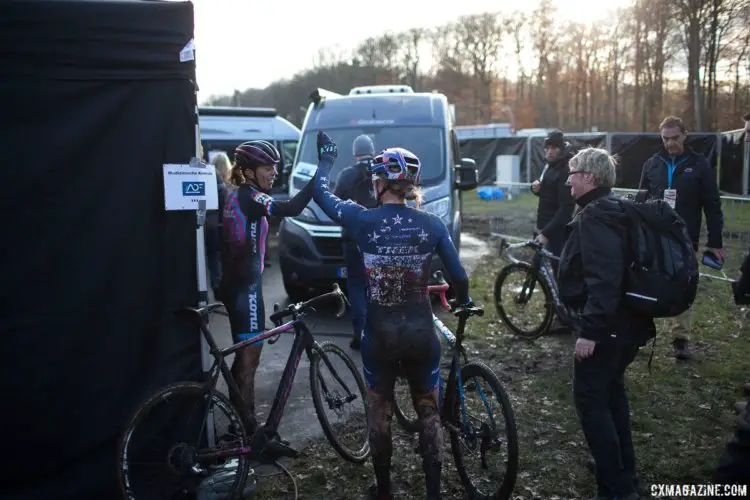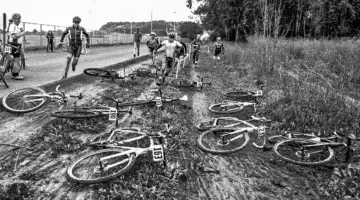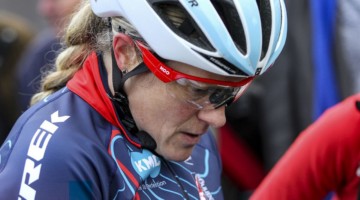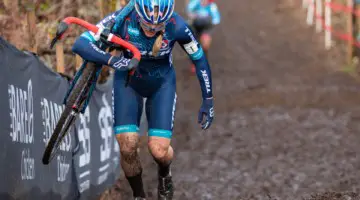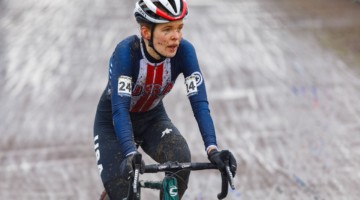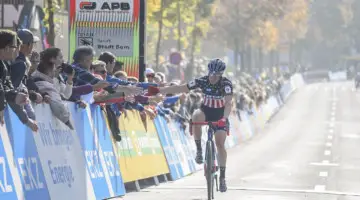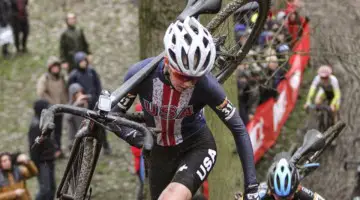It would be fair to say the 2017/18 Telenet UCI World Cup series has not been kind to Katie Compton (KFC Racing p/b Trek/Knight Composites). There were crashes and bee stings at the two U.S. races and a DNS last weekend in Bogense, Denmark due to illness.
When Compton headed to Zeven, Germany, for Saturday’s race, it was a chance to get back on track in the grandaddy of the cyclocross series and build on her success in the IJsboerke Ladies Trofee series she currently leads by over two minutes.
Success at Zeven is something Compton has seen before. Last year, she battled Sanne Cant (Beobank-Corendon) deep into the race before finishing second. This year’s course was a bit different, with no decisive sandpit and an infinitely greater amount of mud, so there was no guarantee last year’s race would be a predictor of the 2017 edition.
One of Compton’s advantages in 2016 was the descents off the hills on the course. In 2017, part of that advantage was neutralized by the combination of mud and design that forced riders off the bike and onto foot. Compton was not amused, “The downhill was just annoying more than anything, especially when the exit could have been designed to make the drop perfectly rideable. It was just slow and awkward from a rider’s perspective.”
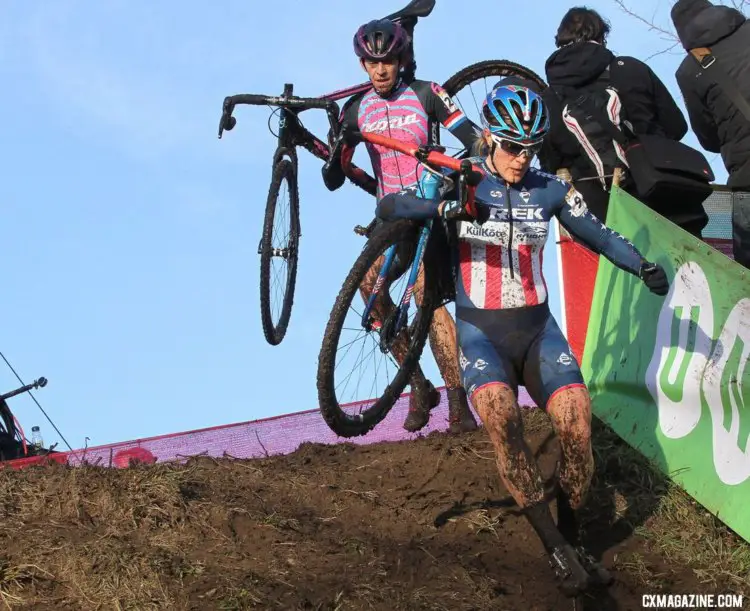
Compton was not thrilled about the descents riders had to run and not ride. Elite Women, 2017 Zeven UCI Cyclocross World Cup. © B. Hazen / Cyclocross Magazine
For much of the race, Compton overcame the annoyances and went off the front with Cant and Helen Wyman (Kona Factory Racing). Her chase for the victory was derailed in the fourth lap after an untimely dab, and she then held on for a third-place finish after Wyman’s blistering last lap, which the Englishwoman talks about in our feature on her second-place finish.
Katie Compton on Trying to Get Zeven with Sanne Cant
New courses such as the one at Zeven can be hit-or-miss in terms of the experience they produce for riders and spectators. Compton offered her thoughts about the northern German layout, “The course was fine, didn’t love it, but they did a good job with what they have to work with and parts of it were fun. It was a typical Euro ’cross course, so it had everything you needed to make it true, muddy ‘field riding.'”
Compton has been open about her past struggles with starts, although in an interview we will be publishing soon, she said she has worked hard in the past year to improve her position early in races. Her hard work paid off on Saturday since the first turn after the holeshot caused a number of crashes and the following section was narrow and muddy.
“I didn’t have any nerves at the start, which was nice,” she said. “I got off to a surprisingly good start after not riding hard and being sick for a couple weeks, so that saved me a lot of energy and gave me time to recover after the effort and just focus on being smooth and getting to the front.”
She continued, “That race is important to have a good start because there is a rut that always forms in the first turn that catches riders off guard and there’s usually a crash, which happened in our race. I got caught behind that last year. It definitely helps to be at the front of that narrow section and the run right after.”
After the first lap, Compton was in the chase group behind Cant and Wyman and she soon broke free to bridge to the front in solo fashion. Watching from afar, it appeared Compton was taking advantage of her legendary power in the thick, muddy straight slogs, but on the ground, was that the case?
“I don’t know, I think I just had a really good third lap,” Compton responded. “I think Helen and Sanne also slowed down a bit that lap, so I was able to catch. I was managing my effort because of the running since I was still coughing quite a bit and didn’t want to overstress my lungs during the race, so I wasn’t digging as deep as I usually would for a World Cup. I was trying to take advantage of every section where I could pedal since running was harder for me.”
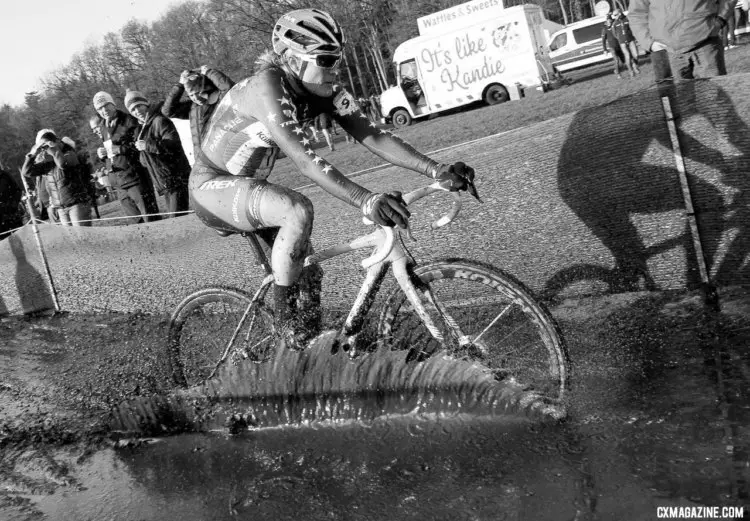
Compton slogged through the mud and puddles to bridge to the two leaders. 2017 Zeven UCI Cyclocross World Cup. © B. Hazen / Cyclocross Magazine
Wyman said staying on the bike in the mud was an advantage for her. The course forced frequent choices between riding and running and penalized riders for hitting the wrong line or losing traction in the mud. Compton said she preferred to make that choice herself, “I’m always reluctant to run since I’m better riding and I like to ride more anyway. I make the decision to run when it’s simply faster while taking less energy. This course was more running than most races I’ve done in a while.”
The importance of riding cleanly on the sloppy afternoon became acutely clear early in the fourth lap. After catching Cant, Compton and the World Champion traded leads in pursuit of the coveted clear look at the mud and ruts.
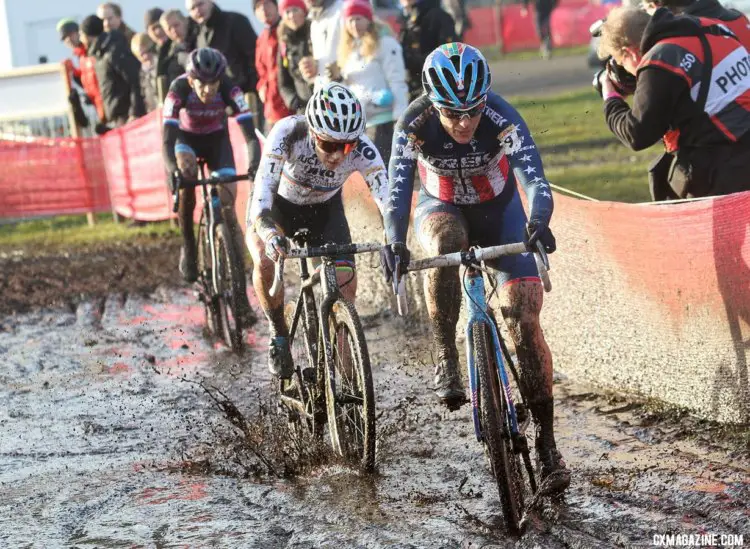
Compton, Cant and Wyman battled at the front of Saturday’s race. 2017 World Cup Zeven. © B. Hazen / Cyclocross Magazine
Cant took the lead into a series of ups and downs along a berm, and on the last one, Compton dabbed and Cant rode it cleanly. The gap was all the World Champion needed to get away and stay away.
“I just took a slightly wide line and lost traction and had to dab,” said Compton. “It was a little mistake that Sanne took advantage of, and I didn’t have the legs to catch back up again. I was riding it half the time, it depended on who was in front of me. The sun glare was strong there too it was hard to see the rut and hit it perfectly.”
The length of the Women’s races has been an on-again, off-again controversy. On Saturday, when the officials put up four-to-go after Wyman’s 10:20 first lap, it was clear the Women were going to be on course for 50+ minutes.
Compton said it was a good thing, at least in theory. “I think its great, we need to race for 50 minutes. I was surprised they ran us that long, but once you’re in race mode, you just look at the laps you have to do and plan your race strategy accordingly. Although, of all the races to race long, that was one I would’ve been happy to cut short!”
And why was that?
“That last lap was awful, my legs and lungs had had enough and were crying mercy!” Compton said. “It was a struggle to keep it together and finish third. I knew Katerina [Nash] was close, so I just focused on the lines and kept moving forward as quickly as I could. Once I got to the top of the last little run-up, I knew it was all downhill and rideable to the finish, so I just went as hard as I could to get the race done.”
Compton got the race done and took home a third-place finish ahead of Nash. The podium was her first World Cup podium of the season, which is somewhat surprising given the success she has had in other races both stateside and on the European continent. To wit, she won both days in Louisville earlier this month, including the Pan-American Championships, and is currently leading the IJsboerke Ladies Trofee season series.
After Saturday’s race, Compton made the trip to Hamme, Belgium for Sunday’s IJsboerke Ladies Trofee Flandriencross race, where she again got to the front and finished third after a tough battle with Cant and Ellen Noble (Aspire Racing). She will be racing in Europe until early January, when she will return to the U.S. to compete for her 14th-straight national championship in Reno.
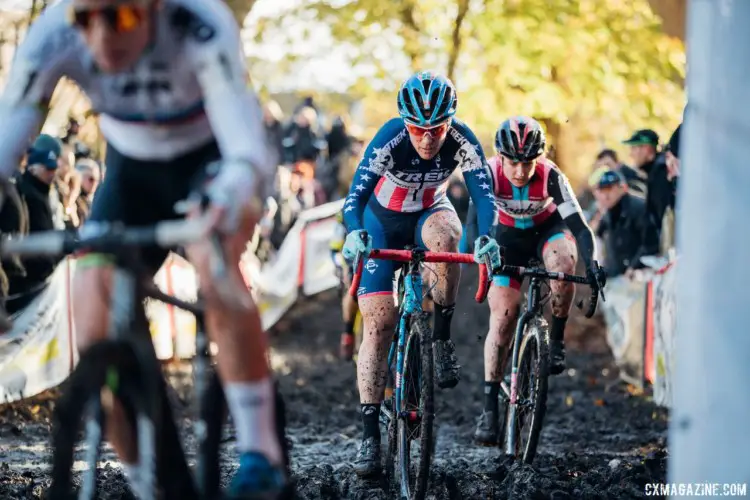
Compton was a part of another great race again on Sunday at Flandriencross. 2017 Flandriencross. © J. Curtes / Cyclocross Magazine
Stay tuned for an extended interview with Compton about her first month of European racing this season.













